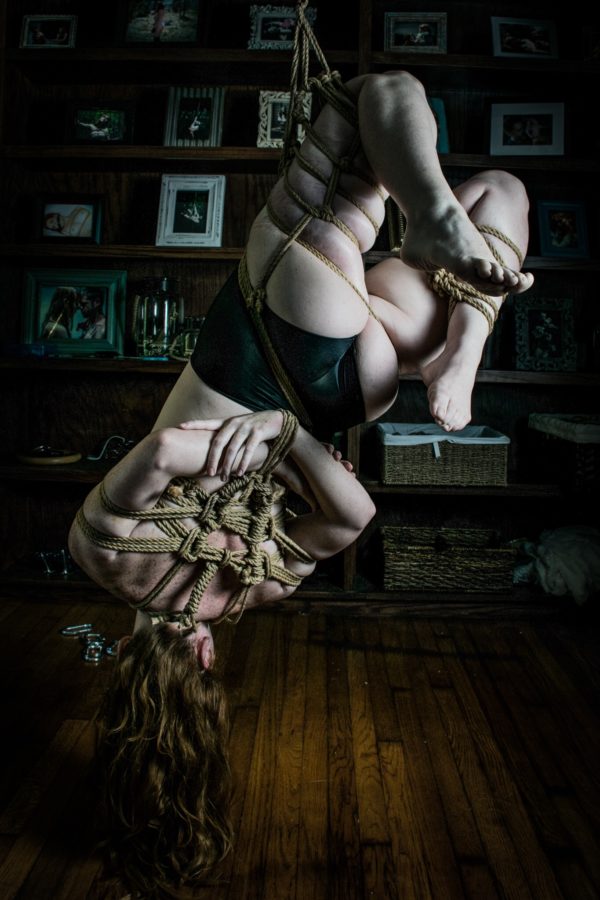After considering some discussion from rope tops about how they help their bottoms evaluate TK’s for safety and placement, I did some thinking on the safety strategies that I have developed from my experiences bottoming. I bottom for rope suspension fairly regularly: several times a week is normal, and several times in a day is not unusual. However, I think the strategies enumerated below are helpful for any rope bottom no matter how frequently you bottom, and they also apply to partial suspensions. These strategies have worked well for me. I’ve never sustained wrist drop or loss of sensation that lasted more than a few hours and I attribute that to solid safety practices, good communication with my tying partners, and probably a bit of luck.
1. Check placement and structure of TK before going into suspension.
Before the TK gets loaded, I do a final placement check by “hulking out” with my arms. I flex my arms and press outward to add more pressure to the bands. If anything feels odd, I ask my top to slightly adjust the bands (run a finger under the bands from the front of the arm to the back, moving the bands slightly higher or lower in the process) until the odd feeling is resolved (re-hulk after each change to see if things get better, worse, or stay the same). For someone new, figuring out what feels odd can be tough, so one way to do this is to compare your arms. Does one arm feel different than the other? Is one side more comfortable? Is there a sensation that you feel in only one area? You’ll start to be able to notice these things more easily with more experience, but in the beginning just try to identify anything that feels out of place. Also, before the TK is loaded is your last chance to check its structural integrity. When you press out with your arms, do the cinches seem to tighten up? Did you lose tension in a certain area? If so, there may be an issue with the way the TK was tied, and it’s better to address it before you are in suspension. After the TK gets loaded, lean into it a bit to check the way the pressure is distributed before any more limbs go up. There are a number of options for tying uplines to a TK: some put pressure on one arm, some both arms, some more on the top bands, some more on the lower bands/chest. If one particular upline feels weird, it may not be the best option for you and you can try a different one, or the top may have inadvertently tied the cinches into the upline (this happens more than you might think). These things are much easier to correct before you are fully suspended, so don’t be afraid to say something if your gut tells you there is a problem. Every top I’ve talked to has said they prefer tying with bottoms that they can trust to speak up when there is an issue. Tops are generally terrified of causing injuries and rely on the bottom’s feedback about their body to keep them safe.
2. Minimize time spent in positions that cause full loss of circulation.
While circulation is not technically the thing we worry about in suspension, loss of circulation can mask problems with nerves. If I go numb in an arm, I will a) do more frequent checks for wrist weakness and b) ask to move to a position that relieves some pressure on that arm so I can allow blood to return to it and verify that I only have circulation issues, not nerve issues. If feeling does not come back immediately after pressure being reduced, I will ask for the TK bands to be popped/adjusted. If I’m still not getting normal feeling returning (pins and needles or other signs of circulation returning), I will ask to come down (and explain why, so they can devise an appropriate exit strategy that does not place further pressure on the areas at risk).
3. Self-check frequently and remain alert throughout a suspension.
I don’t really space out in suspension. Even if I am verbally quiet and have my eyes closed, I am still alert and constantly monitoring my body for warning signs. I pay particular attention to my hands and arms for sensations (or loss of sensations) indicative of nerve issues. These include: shooting pains in an arm, numbness or tingling localized to a particular area of the hands or arm (vs numbness or tingling throughout the limb), inability to move the wrist, or difficulty moving the wrist (if you can’t feel your hand because it is numb, see if you can feel yourself pressing your hands into your back). If I have any signs of issues, I ask for an adjustment. If we are unable to resolve the issue, I come out of suspension. During the untie, I pay attention to the areas that were experiencing issues to see if I can figure out a cause of the issue (did some ropes get twisted increasing pressure on a particular spot? did the bands shift during a transition and end up in a sensitive place? was tension uneven across bands? did the issue stop when a certain rope was removed or moved?). This helps me develop strategies for preventing the same issues in future suspensions. Remind yourself that needing to come down is not a failing on either top’s or bottom’s part. There will always be more chances to go up, but you only have one body, so you have to take care of it.
4. Shift pressure to different areas so that one area does not receive an inordinate amount of pressure for a long time.
Small adjustments in relative height of limbs in suspensions can drastically change the distribution of pressure. If your TK is taking a lot of pressure, you can ask to have other limbs raised higher, or the TK lowered a bit to reduce pressure. Also, it is sometimes helpful to let a limb down and go into a partial suspension while you give certain areas a break, or make adjustments to other areas (placement, relative height of limbs, etc.). Bottoms can do a lot on their own to shift pressure to different areas of their bodies. Alternatively flexing or extending different muscle groups can reduce pressure to certain areas. Try engaging different areas of your body to see if you can shift your weight and ease some pressure (legs, core, back, etc.).
5. Take care of your body and it will take care of you.
a. Drink plenty of water.
I keep “bottom water” (water with a straw in it) nearby when doing any play/lab/scene. It is perfectly OK to ask for water while you are still in bondage.
b. Warm up and stretch your body.
Suspension bondage is a strenuous, athletic activity, and I advise you to treat it as such. Stretching before rope sessions will not only help you get into tougher positions more safely, but time spent stretching is an excellent time to connect deeper with what is going on with your body that day. What is your energy level like? Note any areas of soreness, sensitivity, and/or stiffness, and communicate those to your top so they can adjust their plans accordingly.
c. Understand that nerve damage is cumulative.
If you are going to be in TK’s multiple times in a short period of time, realize that you are putting yourself at increased risk for nerve damage. You can attempt to mitigate that by alternating which arm takes more pressure in each suspension. Before I go in any suspension, I tell my top which side of my body is feeling stronger at that time, so they can plan accordingly. You can try different styles of TK’s like the chest-loading TK (CTK) by topologist that reduces pressure to the arms. If I have been doing a lot of bondage and my arms are getting fatigued, I ask my top to use the CTK on me (or not use TK’s at all) until my arms are feeling better.





